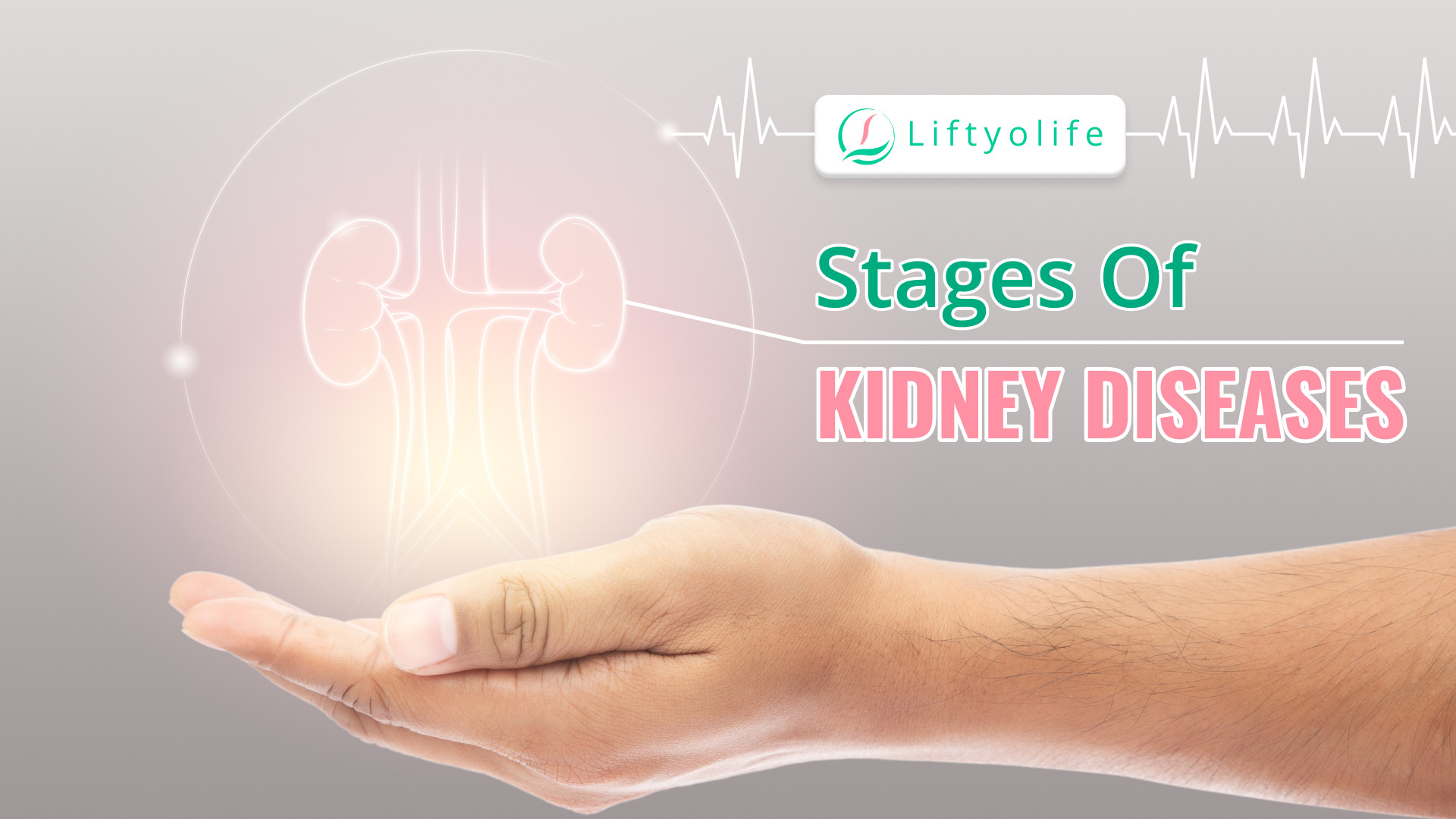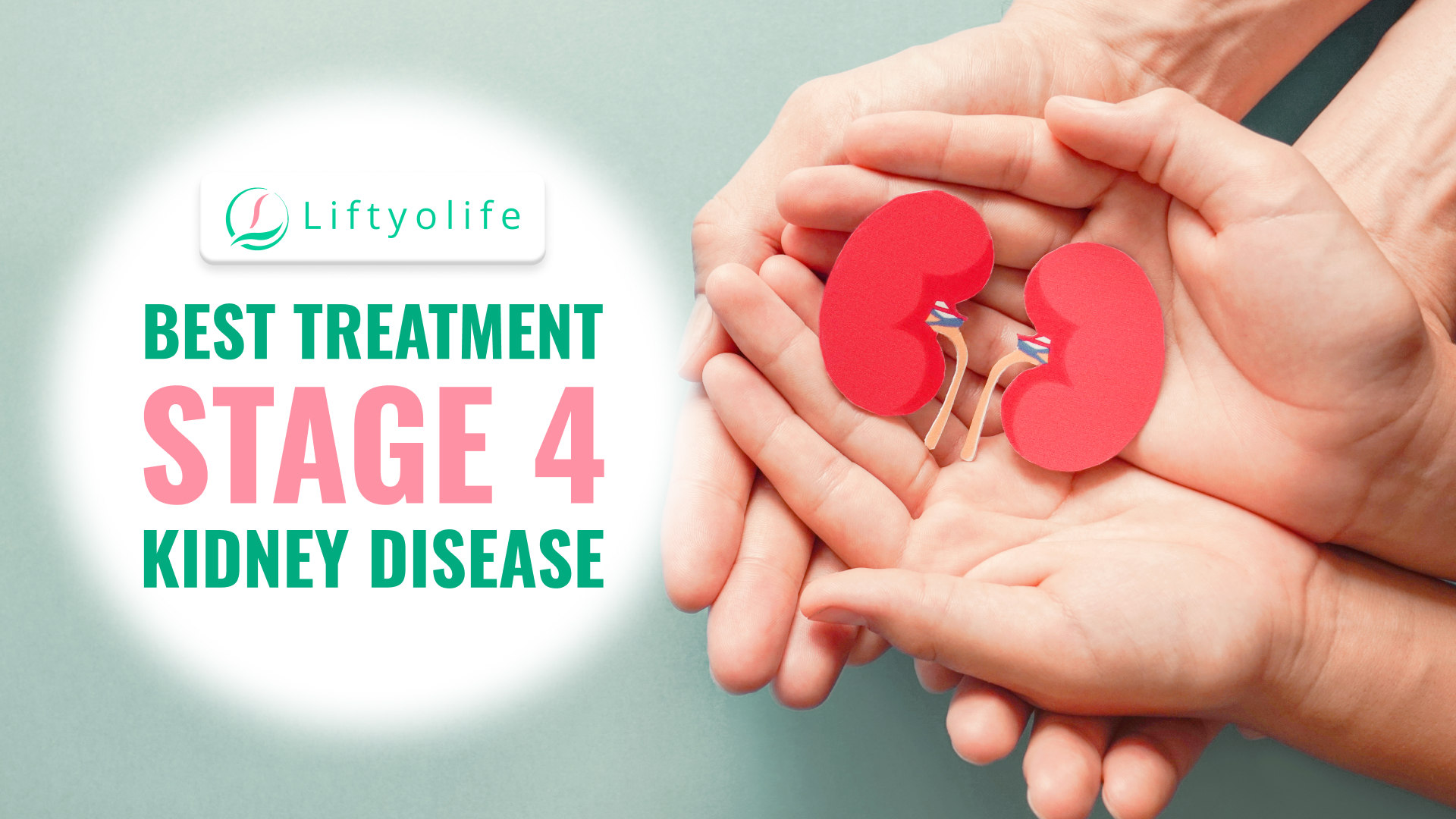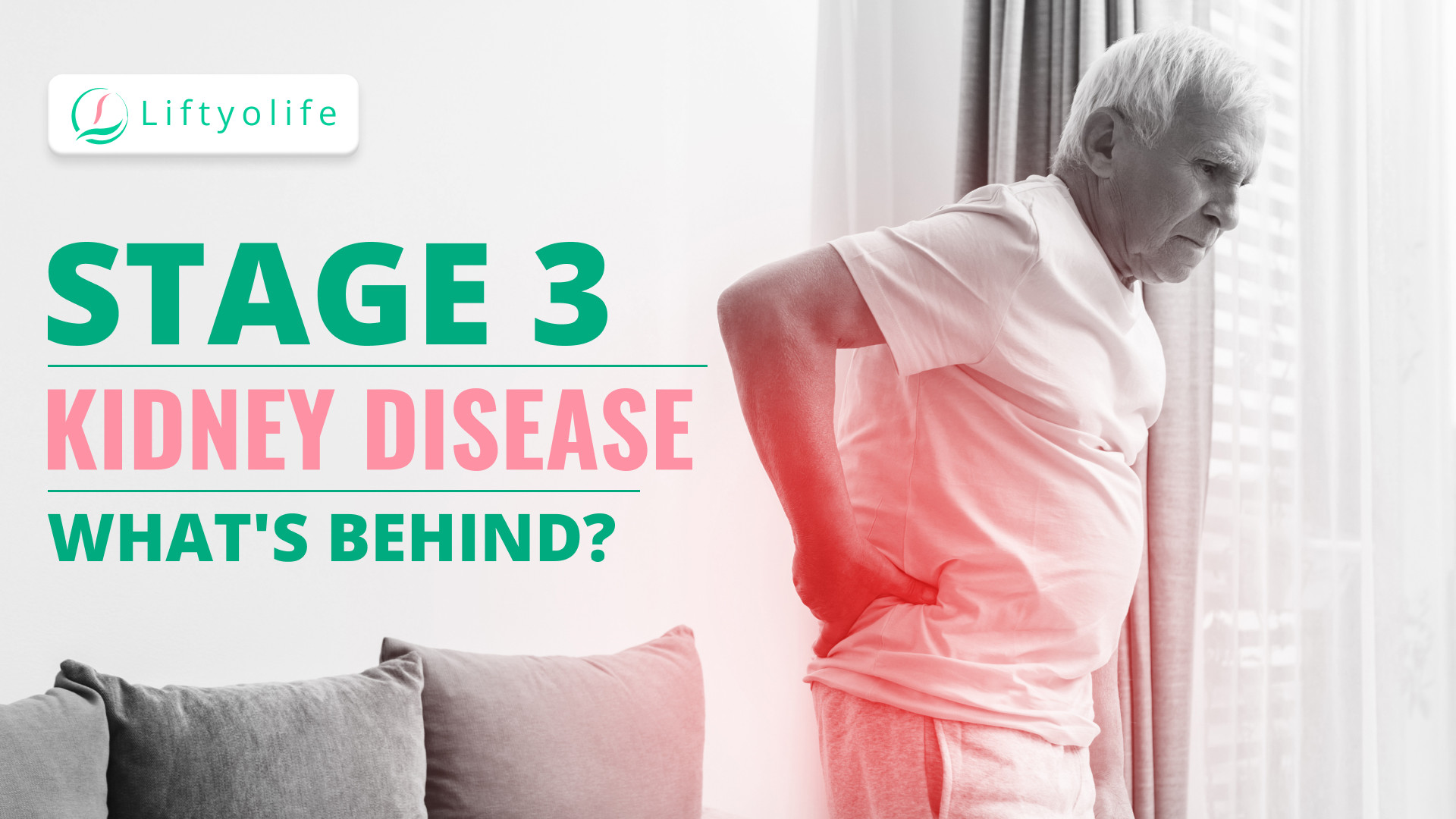Stages Of Kidney Disease

Have you heard of the 5 stages of kidney disease? What are they, exactly? First, you should fill the knowledge gap of this disease. Chronic kidney disease is a catch-all term for various disorders affecting the structure and function of the kidney. The variation in disease expression is related to the cause and pathology of the disease and the severity and rate of progression (1). Then it’s time to figure out what stage of the disease you’re in or your loved ones have been. You only need to stay here and read; Liftyolife (liftyolife.com) will help you with the rest.
1. What do the stages of chronic kidney disease (CKD) refer to?
Chronic kidney disease’s stages (CKD) are determined by the eGFR (estimated Glomerular Filtration Rate) test result and the productivity with which your kidneys filter waste and extra fluid from your blood. At each stage of CKD, the goal is to take steps to slow the damage to your kidneys and keep them working as long as possible.
Kidney disease is classified into five stages by the National Kidney Foundation (NKF). The five stages of CKD refer to how well your kidneys function. The kidneys do not usually fail all at once in chronic disease. Instead, this disease frequently progresses slowly over time. Specifically, your kidneys can still filter waste from your blood in the early stages (Stages 1–3). After that, they must work harder to filter your blood in the later stages (Stages 4–5) and may stop working entirely.
2. How is kidney disease measured and divided into stages?
The kidneys’ primary function is to remove water-soluble waste products from the blood (such as creatinine). A blood test is used to check the eGFR to determine the stage of kidney disease. This shows how much blood is filtered through the kidneys every 60 seconds.
The GFR (glomerular filtration rate) measures how much blood (in milliliters) the kidneys ‘clean’ in one minute. However, we can calculate the estimated GFR, known as eGFR, using a blood test to measure creatinine levels.

How is kidney disease measured and divided into stages?
Because the normal eGFR is 100 on average, the eGFR can be viewed as a percentage of normal kidney function. However, if there is no other evidence of kidney disease, values as low as 60 are considered normal.
The eGFR is used to determine CKD’s ‘G stage,’ as shown below.
2.1. Stage 1 CKD: eGFR 90mL/min or greater
Because kidneys function well even when they aren’t functioning at 100%, most people are unaware they have stage 1 kidney disease. At stage 1, you have an eGFR of 90mL/min or higher, mild kidney damage, and normal kidney function. Typically, no symptoms indicate that the kidneys have been damaged. Therefore, at this stage, it’s critical to keep a close eye on your health and make lifestyle changes that can assist you in slowing the progression of CKD and lower your risk of kidney damage or other complications.
Symptoms and signs of stage 1 kidney disease are:
- High blood pressure.
- Higher creatinine or urea levels in the blood than normal
- Swelling of the legs
- Urinary tract infections
- Unusual urine test results (blood or protein in the urine)
- An MRI, CT scan, ultrasound, or contrast X-ray may reveal evidence of kidney damage.
- A family history of polycystic kidney disease (PKD)
Treatment of stage 1 CKD:
A healthy way of life can help slow the progression of kidney disease. Regular urine protein and serum creatinine testing can reveal whether kidney damage progresses. People with stage 1 CKD should do the following:
- Consume a nutritious diet.
- Maintain a healthy blood pressure level for them.
- 125/75: Diabetes patients should have.
- 130/85: Non-diabetes and non-proteinuria
- 125/75: Non-diabetics with proteinuria should take.
- Maintain control of their blood sugar or diabetes.
- Should see a doctor regularly and have a serum creatinine test to determine their GFR.
- Take medications as directed by their doctor.
- Regular exercise is essential.
- Quit smoking.
Living with stage 1 kidney disease:
Although there is no cure for kidney disease and kidney damage, you can begin slowing the progression of CKD now. Each person’s experience with kidney disease is unique. Many people diagnosed with kidney disease in the early stages never develop kidney failure, and those who do develop kidney failure later in life can live well for decades with treatment.
2.2. Stage 2 CKD: eGFR between 60mL/min and 89mL/min
A stage 2 CKD has kidney damage, mild loss of kidney function and a GFR of 60-89 ml/min. Typically, no symptoms indicate that the kidneys have been damaged. Because kidneys function well even when they aren’t functioning at 100%, most people are unaware they have stage 2 CKD. Usually, they discover they have stage 2 kidney disease while being tested for another condition like diabetes or high blood pressure–the two leading causes of kidney disease.
Symptoms, signs and treatment of stage 2 kidney disease are also the same as stage 1 because both stages are in the early progress of this disease.
2.3. Stage 3 CKD: eGFR between 30mL/min and 59mL/min
A person with CKD in stage 3 has moderate kidney damage. This stage is divided into two parts: a decrease in GFR of 45-59 mL/min for Stage 3A and a decrease in GFR of 30-44 mL/min for Stage 3B. As kidney function deteriorates, waste products can accumulate in the blood, resulting in a condition called “uremia.” Moreover, in stage 3, a person is more likely to develop kidney disease complications such as high blood pressure, anemia (a lack of red blood cells), or early bone disease.
2.3.1. Stage 3A: eGFR 45-59mL/min
Stage 3A of CKD is mild to moderate loss of kidney function.
Symptoms may begin to appear in stage 3A:
- Fatigue
- Changes in Urination (foamy; dark orange, brown, tea-colored, or red if it contains blood; and urinating more or less than usual)
- Kidney pain in their back.
- Fluid retention, extremity swelling (edema), and shortness of breath.
- Sleep issues because of muscle cramps or restless legs.
- Hand and foot swelling.
- Dry and itchiness of the skin.
See a doctor at stage 3A CKD:
A nephrologist should be consulted as stage 3 progress (a doctor who specializes in treating kidney disease). Nephrologists examine patients and perform lab tests to gather their condition and provide the best treatment advice. The goal of a nephrologist is to help their patients keep their kidneys working for as long as possible.
Living with stage 3A kidney disease:
Aside from eating right and taking prescribed medications, regular exercise and not smoking can help to extend kidney health. Patients should consult with their doctors about developing an exercise regimen. Moreover, doctors can also offer advice on how to quit smoking.
2.3.2. Stage 3B | eGFR 30-44mL/min
Stage 3B of CKD is moderate to a severe loss of kidney function. All symptoms, treatment, and prevention of stage 3A is almost the same as stage 3B, specific as:
Symptoms may begin to appear in stage 3B:
- Fatigue
- Changes in Urination (foamy; dark orange, brown, tea-colored, or red if it contains blood; and urinating more or less than usual)
- Kidney pain in their back.
- Fluid retention, extremity swelling (edema), and shortness of breath.
- Sleep issues because of muscle cramps or restless legs.
- Hand and foot swelling.
- Dry and itchiness of the skin.
See a doctor at stage 3A CKD:
A nephrologist should be consulted as stage 3 progress (a doctor who specializes in treating kidney disease). Nephrologists examine patients and perform lab tests to gather their condition and provide the best treatment advice. The goal of a nephrologist is to help their patients keep their kidneys working for as long as possible.
Living with stage 3B kidney disease:
Aside from eating right and taking prescribed medications, regular exercise and not smoking can help to extend kidney health. Patients should consult with their doctors about developing an exercise regimen. Moreover, doctors can also offer advice on how to quit smoking.
2.4. Stage 4 CKD: eGFR between 15mL/min and 29mL/min
A stage 4 CKD has advanced kidney damage, severe loss of kidney function, and a significant decrease in GFR to 15-30 ml/min. Dialysis or a kidney transplant are likely in the near future for someone with stage 4 CKD.
As kidney function deteriorates, waste products accumulate in the blood, resulting in uremia. A person in stage 4 is more likely to develop kidney disease complications such as high blood pressure, bone disease, anemia (a lack of red blood cells), heart disease, and other cardiovascular diseases.
Symptoms of stage 4 kidney disease:
- Anemia
- Bone disease
- Phosphorus, calcium, or vitamin D levels in the blood are abnormal.
- Fatigue
- Fluid retention, swelling (edema) of extremities, and shortness of breath
- Changes in urination (foamy; dark orange, tea-colored, brown, or red)
- Kidney pain in back
- Sleep disturbances caused by muscle cramps or restless legs
- Vomiting or nausea
- Taste changes metallic taste in the mouth
- Appetite loss
- Bad breath since urea buildup in the blood
- Concentration problems
- Nerve issues: Numbness or tingling in the toes or fingers is a CKD symptom.
See a doctor at stage 4 CKD:
People with stage 4 CKD should see their doctor at least every three months. Whenever re-examination, blood tests for creatinine, calcium, hemoglobin, and phosphorus levels will be performed to determine how well the kidneys are working. Other conditions like high blood pressure and diabetes will also be monitored by the doctor. In addition to assisting the patient in keeping their kidneys functioning as long as possible, the nephrologist will help the patient prepare for dialysis or a kidney transplant.
Living with stage 4 kidney disease:
People in stage 4 should keep their blood pressure and glucose levels for diabetes under control. Taking all your medicines as directed by your doctor may help you live a longer life.
The NKF recommends beginning dialysis when kidney function drops to 15% or less. The goal is to avoid dialysis or transplant as long as possible by doing everything possible to keep kidney function and overall health.
2.5. Stage 5 CKD: eGFR less than 15mL/min
Stage 5 CKD or ESRD (end-stage renal disease) occurs when your eGFR falls below 15; describe your kidney’s failure or close to failure. In other words, the kidneys have lost nearly all of their ability to do their job effectively, and survival will require dialysis or a kidney transplant.
Symptoms of stage 5 kidney disease (ESRD):
- Uremia (waste buildup in your blood).
- Fatigue – possibly as a result of anemia.
- Breathing difficulty.
- Vomiting or nausea.
- Appetite loss.
- Headaches.
- Inability to concentrate.
- Itching.
- Producing little or no urine.
- Swelling, particularly near the eyes and ankles.
- Cramps in the muscles.
- Tingling sensations in the hands or feet.
- Skin pigmentation has increased.
- Changes in skin color.
What you can do:
- To take the best care and control of your health, follow the steps outlined in the previous stages.
- Consult with your insurance coordinator to learn more about your insurance coverage options.
- See your kidney doctor (nephrologist) regularly to monitor your progress.
- Prepare your treatment area and learn what to expect from training if you’ve chosen home dialysis.
- If you’ve decided on in-center dialysis, go on a tour of a nearby dialysis center and get answers to your questions.
- Learn everything you can about surviving on dialysis and maintaining an active lifestyle. If you work, learn about your rights and deal with work and treatment.
Living with stage 5 kidney disease:
When you start dialysis, you will need to change your diet and drinking habits. Because your diet is an essential part of your treatment, you will work with a dietitian who will advise you on eating.
3. Reducing the impact of kidney disease

Reducing the impact of kidney disease
You can keep your kidneys healthy by avoiding or managing kidney-damaging diseases such as diabetes and high blood pressure by some points as below:
- Make nutritious food choices.
- Make physical activity a regular part of your routine.
- Strive for a healthy weight.
- Get enough sleep and quit smoking
- Limit your alcohol consumption.
- Look into stress-relieving activities.
- Blood pressure, heart disease, and diabetes should all be managed.
Moreover, in case you develop a urinary tract infection (UTI), see a doctor right away because it can cause kidney disease if left untreated.
You should ask your doctor about your kidney health during your next visit. Because early kidney disease may not have any symptoms, getting tested is perhaps the only way to know whether your kidneys are in good working order or not. Therefore, your doctor will advise you on how frequently you should be tested. The five stages of kidney disease listed above will help you understand how serious they are to your kidneys’ health. Liftyolife (liftyolife.com) would like to remind you once more about kidney screening in order to detect disease at an early stage.
==> Read More:







